Peer-to-peer lending platforms have gained popularity in recent years as an alternative to traditional banking methods. These platforms allow individuals to borrow and lend money directly to each other, cutting out the middleman. Some of the best peer-to-peer lending platforms include LendingClub, Prosper, and Upstart.
LendingClub is one of the largest platforms, with over 3 million members and more than $50 billion in loans funded. Prosper, founded in 2005, has facilitated over $15 billion in loans and has a strong focus on personal loans. Upstart, on the other hand, uses artificial intelligence to determine creditworthiness and has a focus on lending to those with limited credit history.
All of these platforms offer competitive interest rates, easy application processes, and quick access to funds. However, it’s important to carefully review the terms and conditions of each platform before borrowing or lending money.
What Is Peer To Peer Lending Platforms?
P2P lending platforms are online markets that connect lenders and borrowers in a direct exchange. These platforms make it possible for people and companies to borrow money directly from one another instead of going via banks or other traditional financial institutions.
P2P lending platforms provide borrowers a substitute for traditional loans by enabling them to obtain funds at interest rates that are lower than those they would traditionally pay to banks.
The lending options available on the platforms range from personal loans to company loans to school loans. On the platform, borrowers submit loan applications, and after those are accepted, the loans are posted for funding.
Once enough investors commit to funding a loan, the money is disbursed to the borrower. Investors can then decide to invest in loans that satisfy their requirements. Peer-to-peer lending platforms typically charge fees to both borrowers and lenders, which is how they make their money.
What are the risks of peer-to-peer lending sites?
There are a number of hazards involved with investing or borrowing through peer-to-peer lending platforms, despite the fact that they can provide investors with attractive returns and borrowers with cheaper interest rates:
Default risk: If borrowers don’t repay their debts, lenders could suffer losses. By running credit checks on borrowers, P2P lending platforms attempt to reduce this risk, but there is still a chance that borrowers won’t pay back their loans.
Lack of liquidity: P2P loans are not easily marketable, unlike stocks and bonds, thus investors may have trouble selling their loans if they need to access their money right away.
Platform risk: If the P2P lending platform itself fails, investors could lose money. It’s crucial to pick a trustworthy, established platform with a proven track record.
Regulatory risk: The regulatory landscape for P2P lending platforms is still developing, and regulatory changes may have an effect on the market and the profits investors see.
Information risk: To determine credit risk, P2P lending platforms rely on precise and timely information about borrowers. This information could be erroneous or deceptive, which could have an effect on how well loans perform.
Here Is List Best Peer To Peer Lending Platforms
- Upstart
- Prosper
- LendingClub
- LenDenClub
- Finzy
- Lendingkart
- i-Lend
- Paisa Dukaan
- Lend Box
- Rupee Circle
1. Upstart
Upstart is a peer-to-peer lending platform that evaluates creditworthiness and disburses personal loans using artificial intelligence and machine learning algorithms. Upstart, a platform for peer-to-peer lending, was founded in 2012 and has since grown to be one of the biggest, having backed over $12 billion in loans.
To determine a borrower’s risk profile, Upstart’s innovative underwriting system takes into account elements other than traditional credit scores, like education and work experience. As a result, Upstart is able to give loans to clients who conventional lenders might pass over.
The website provides personal loans with loan amounts ranging from $1,000 to $50,000 for a number of uses, including debt consolidation, home upgrades, and medical costs.
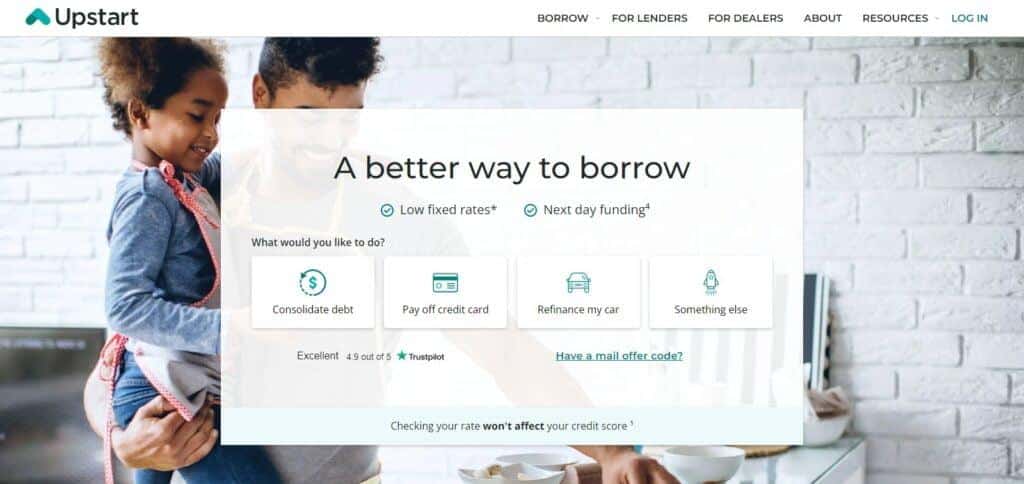
Most applicants for Upstart receive a decision within minutes of applying, and the application procedure is quick and simple. If accepted, cash may be disbursed as early as the following business day to the borrower’s bank account. Depending on the borrower’s creditworthiness, Upstart assesses a one-time origination fee that can range from 0% to 8% on loans.
Through the platform’s marketplace, which includes an automatic investment tool and a secondary market for buying and selling loans, investors can invest in Upstart loans. Investors who desire a tax-advantaged account to hold loans might choose Upstart’s retirement account option.
2. Prosper
Without the help of traditional financial institutions like banks, people may borrow and lend money directly to each other through Prosper, a peer-to-peer lending network. With over $15 billion in loans processed, Prosper is one of the largest and most established P2P lending platforms in the United States. It was launched in 2005.
Personal loans are available from Prosper for a range of things, such consolidating debt, making home upgrades, and paying for medical expenditures. Loan amounts range from $2,000 to $40,000, with three or five-year repayment schedules.
On the website, borrowers submit loan applications; if authorised, their loans are published on the funding marketplace. Then, investors can decide whether to invest in a borrower’s loan; loans are frequently backed by a number of investors.
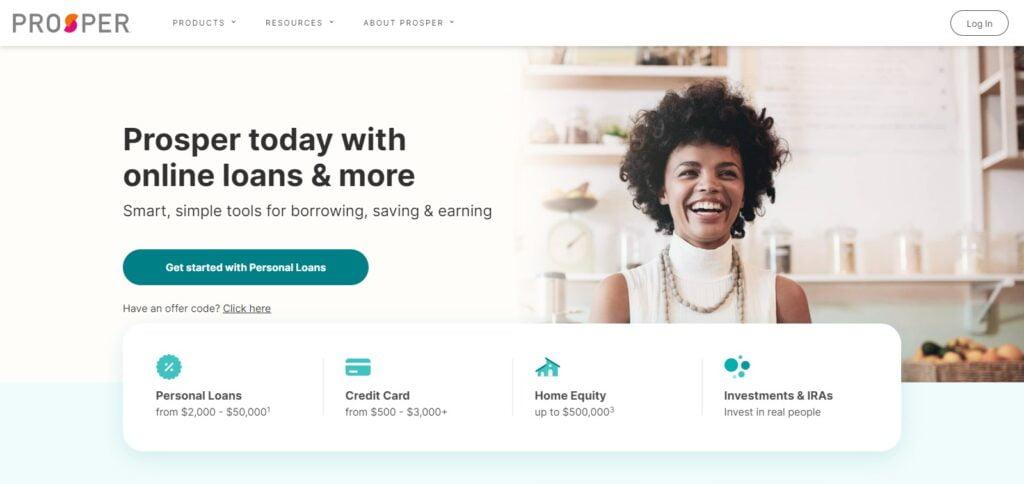
Prosper provides investors with a range of investment alternatives, including automated investing based on a borrower’s credit profile and human loan selection. Investors are assessed a 1% annual service fee on their remaining principle amount by Prosper.
Borrowers’ credit histories are checked by Prosper, which then gives them a Prosper Rating based on how creditworthy they are. The platform also features a secondary market where investors may buy and sell loans, giving them access to funds in case they need to before the loan period expires.
Borrowers and investors should nevertheless carefully assess the dangers connected with P2P lending, such as default risk and a lack of liquidity, even though Prosper offers attractive rates and a variety of investment possibilities. Reviewing the terms and conditions of the platform is also essential.
3. LendingClub
A peer-to-peer lending network called LendingClub enables investors to fund loans for customers and companies. Having processed more than $63 billion in loans since its founding in 2007, LendingClub is one of the biggest and most reputable P2P lending platforms in the United States.
Personal loans are available from LendingClub for a range of needs, such as debt relief, home renovations, and medical costs. Loan amounts range from $1,000 to $40,000, with three or five-year repayment schedules.
On the website, borrowers submit loan applications; if authorised, their loans are published on the funding marketplace. Then, investors can decide whether to invest in a borrower’s loan; loans are frequently backed by a number of investors.
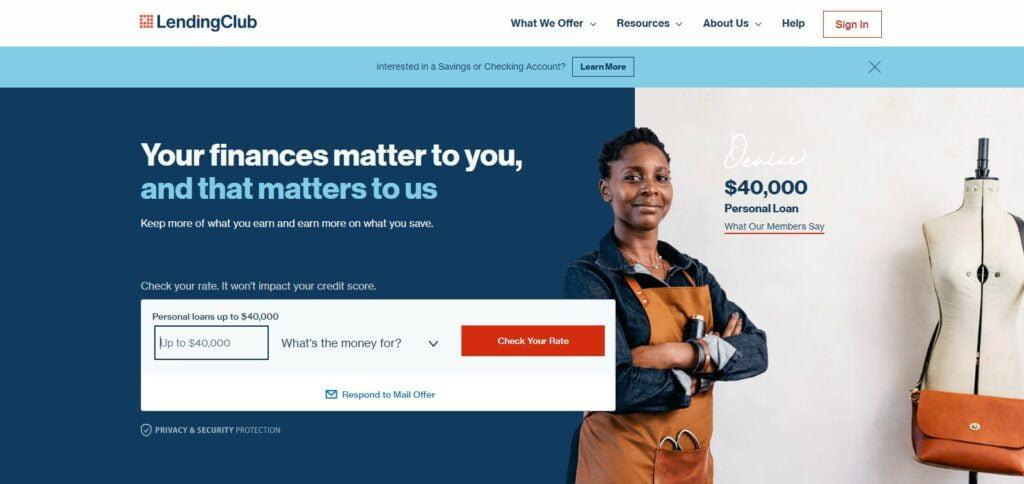
LendingClub provides investors with a variety of investment options, including manual loan selection and automatic investing based on a borrower’s credit profile. It also issues borrowers a credit score depending on their creditworthiness. Investors pay a 1% annual service fee on their outstanding principle balance to LendingClub.
Additionally, LendingClub offers a secondary market where investors can purchase and sell loans, giving them access to funds if they need it before the loan period expires. The portal provides resources to aid investors in diversifying their holdings across various loans and credit ratings.
Although LendingClub offers reasonable rates and a variety of investment possibilities, investors and borrowers alike should nevertheless take P2P lending risks including default risk and liquidity issues very seriously. It’s also significant.
4. LenDenClub
LenDenClub is an Indian peer-to-peer lending network that links lenders with individual borrowers instead of using established financial institutions. The company, which was established in 2014, has expanded to rank among the biggest P2P lending platforms in India.
LenDenClub provides personal loans for a range of needs, such as debt relief, home renovations, and medical costs. Loan durations of three to 36 months are available, with loan amounts ranging from 25,000 to 5 lakhs of Indian rupees.
On the website, borrowers submit loan applications; if authorised, their loans are published on the funding marketplace. Then, investors can decide whether to invest in a borrower’s loan; loans are frequently backed by a number of investors.
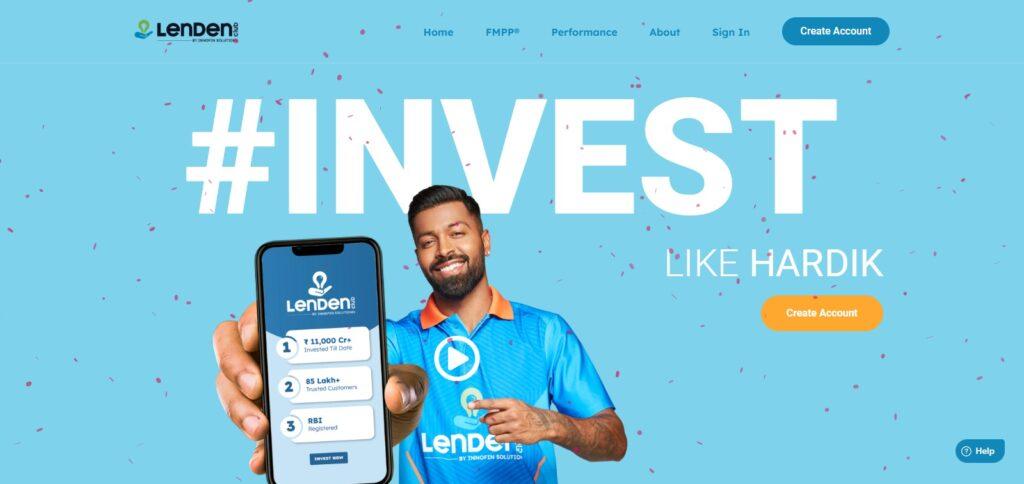
LenDenClub provides investors with a variety of investment alternatives, including manual loan selection and automatic investing based on a borrower’s credit profile. It also issues borrowers a credit score depending on their creditworthiness. A 1% service fee is levied by the platform on the principal repayment amount for investors.
In addition to traditional credit ratings, LenDenClub uses a unique algorithm to evaluate a borrower’s creditworthiness based on aspects including income, employment, and education. Additionally, the platform provides investors with capabilities to diversify their portfolios across various loans and credit ratings.
5. Finzy
Individual lenders can lend money to borrowers directly through Finzy, an Indian peer-to-peer lending website. With over INR 200 crores in loans processed, the company, which was created in 2016, is among India’s fastest-growing P2P lending platforms.
Finzy provides personal loans for a range of needs, such as consolidating debt, making home modifications, and paying for medical bills. Loan durations of six to 36 months are available, with loan amounts ranging from 50,000 to 10 lakhs of Indian rupees.
On the website, borrowers submit loan applications; if authorised, their loans are published on the funding marketplace. Then, investors can decide whether to invest in a borrower’s loan; loans are frequently backed by a number of investors.
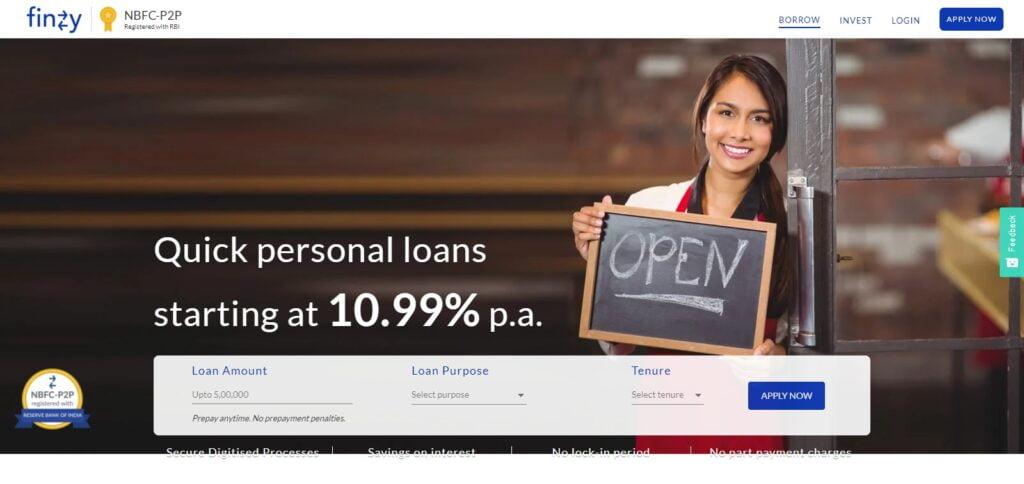
Finzy provides investors with a variety of investment options, including manual loan selection and automatic investing based on a borrower’s credit profile. Finzy also issues borrowers a credit score depending on their creditworthiness. Investors are charged a service fee of 1% of their remaining principle balance by Finzy.
In addition to typical credit ratings, Finzy uses a proprietary algorithm to evaluate a borrower’s creditworthiness based on things like income, employment status, and education. Additionally, the platform provides investors with capabilities to diversify their portfolios across various loans and credit ratings.
6. Lendingkart
Small and medium-sized businesses (SMEs) and startups can apply for working capital loans and business loans through Lendingkart, an Indian-based digital lending platform. Since its establishment in 2014, the platform has awarded loans totaling over 10,000 crores of Indian rupees.
With maturities of one to 36 months, Lendingkart offers loans with amounts ranging from 50,000 to 2 crores of Indian rupees. On the portal, borrowers submit loan applications and supply personal and business information.
Lendingkart evaluates a borrower’s creditworthiness using a unique algorithm that takes into account aspects including financial stability, credit score, and payback history.
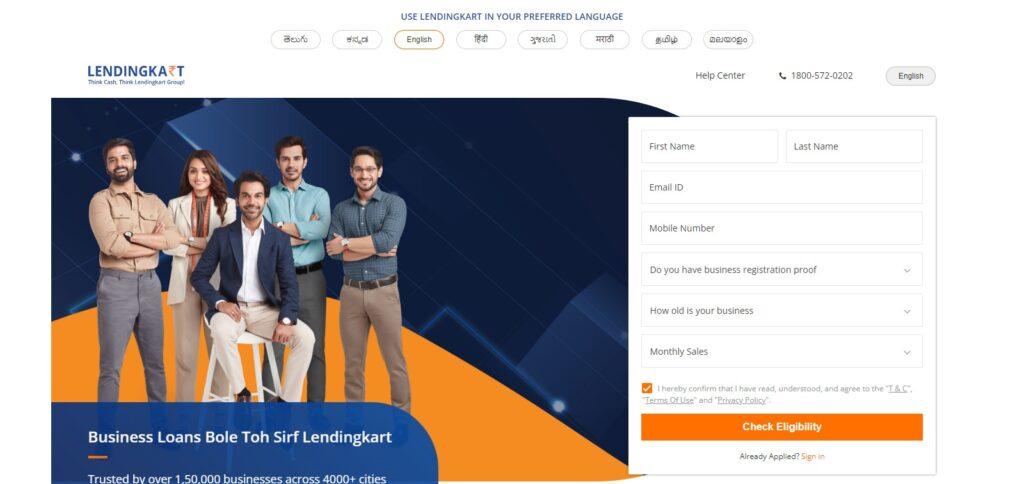
With the majority of loans authorised and funded in within 72 hours, Lendingkart offers speedy loan approvals and disbursals. Additionally, the site provides different payment schedules, such as biweekly and monthly installments.
Borrowers pay processing fees ranging from 1% to 4% of the loan amount to Lendingkart, and interest rates start at 1.2% monthly. The platform also provides a number of services, like as accounting software and invoicing tools, to assist borrowers in managing their business finances.
Although Lendingkart provides SMEs and startups with rapid and adaptable funding solutions, borrowers should carefully read the terms and conditions and consider their capacity to repay the loan before applying.
7. i-Lend
Peer-to-peer lending network i-Lend, located in India, links individual lenders and borrowers instead of using established financial institutions. One of the first P2P lending platforms in India, the platform was established in 2013.
Personal loans are available from i-Lend for a range of needs, such as consolidating debt, making home modifications, and paying for medical bills. Loan durations of three to 36 months are available, with loan amounts ranging from 25,000 to 10 lakhs of Indian rupees. On the website, borrowers submit loan applications; if authorised, their loans are published on the funding marketplace. Then, investors can decide whether to invest in a borrower’s loan; loans are frequently backed by a number of investors.
i-Lend provides investors with a variety of investment options, including manual loan selection and automatic investing based on a borrower’s credit profile. It also assigns borrowers a credit score depending on their creditworthiness. A 1% service fee is levied by the platform on the principal repayment amount for investors.
In addition to typical credit ratings, i-Lend uses a proprietary algorithm to evaluate a borrower’s creditworthiness. This algorithm takes into account things like income, employment status, and education. Additionally, the platform provides investors with capabilities to diversify their portfolios across various loans and credit ratings.
Even though i-Lend provides low rates and cutting-edge underwriting technologies, investors and borrowers should nevertheless take P2P lending risks including default risk and liquidity issues very seriously. Reviewing the terms of the platform is also essential and conditions before investing or borrowing.
8. Paisa Dukaan
An Indian peer-to-peer lending platform called Paisa Dukaan links borrowers and lenders directly. The platform was established in 2019 with the goal of giving consumers and small businesses access to inexpensive financing.
Personal loans are available from Paisa Dukaan for a range of needs, including as debt relief, schooling, and medical costs. Loan durations of three to 36 months are available, with loan amounts ranging from 10,000 to 50 lakhs of rupees. On the website, borrowers submit loan applications; if authorised, their loans are published on the funding marketplace. Then, investors can decide whether to invest in a borrower’s loan; loans are frequently backed by a number of investors.
Utilising a unique algorithm, Paisa Dukaan determines a borrower’s creditworthiness and provides them a credit score a borrower’s ability to repay the loan. The platform also offers tools to help investors diversify their portfolios across multiple loans and credit.
Borrowers pay processing fees ranging from 1% to 6% of the loan amount to Paisa Dukaan, and interest rates start at 13.5% annually. Investors are additionally charged a 1% service fee on the principal repayment amount by the platform.
Although Paisa Dukaan offers reasonable rates and cutting-edge underwriting technologies, investors and borrowers alike should nevertheless take P2P lending risks including default risk and liquidity issues very seriously. Before making an investment or loan, it’s crucial to read the terms and conditions of the site.
9. Lend Box
An Indian company called Lendbox operates a peer-to-peer lending network that links borrowers and independent lenders. The platform, which was established in 2014, promises to give both individuals and businesses access to affordable financing.
Personal loans are available through Lendbox for a range of needs, such as debt relief, home renovations, and medical costs. Loan durations of three to 36 months are available, with loan amounts ranging from 25,000 to 10 lakhs of Indian rupees.
On the website, borrowers submit loan applications; if authorised, their loans are published on the funding marketplace. Then, investors can decide whether to invest in a borrower’s loan; loans are frequently backed by a number of investors.
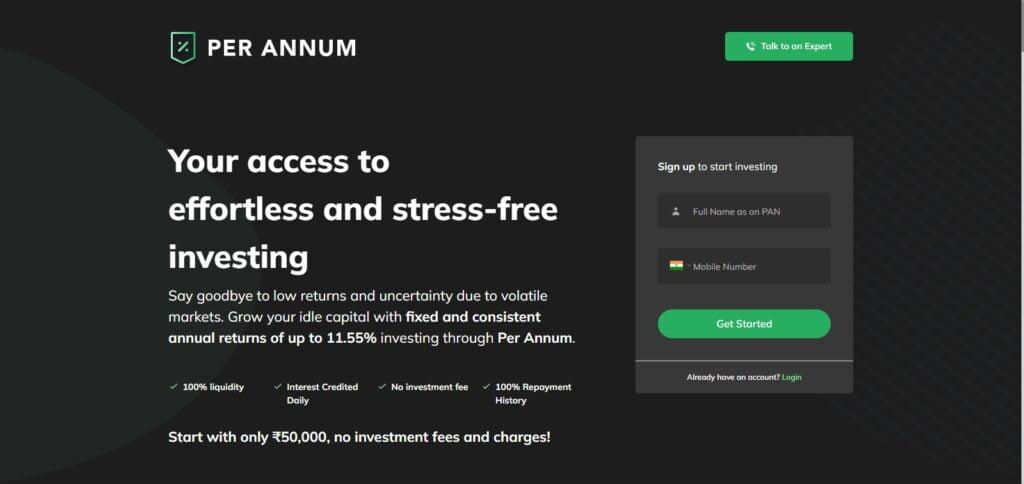
Lendbox employs a proprietary algorithm to evaluate a borrower’s capability and assigns borrowers a credit score based on their creditworthiness to repay the loan. The platform also offers tools to help investors diversify their portfolios across multiple loans and credit grades.
Processing fees ranging from 2% to 6% of the loan amount are assessed to borrowers through Lendbox, and interest rates start at 12% annually. Investors are additionally charged a 1% service fee on the principal repayment amount by the platform.
Even though Lendbox offers attractive rates and cutting-edge underwriting technologies, investors and borrowers should nevertheless take P2P lending risks including default risk and liquidity issues very seriously. Before making an investment or loan, it’s crucial to read the terms and conditions of the site.
10. Rupee Circle
An Indian peer-to-peer lending platform called Rupee Circle links borrowers and private lenders. The platform was established in 2018 with the goal of offering both individuals and businesses accessible and affordable loans.
Personal loans are available from Rupee Circle for a range of needs, including as debt reduction, schooling, and medical costs. Loan durations of six to 36 months are available, with loan amounts ranging from 25,000 to 15 lakhs of Indian rupees.
On the website, borrowers submit loan applications; if authorised, their loans are published on the funding marketplace. Then, investors can decide whether to invest in a borrower’s loan; loans are frequently backed by a number of investors.
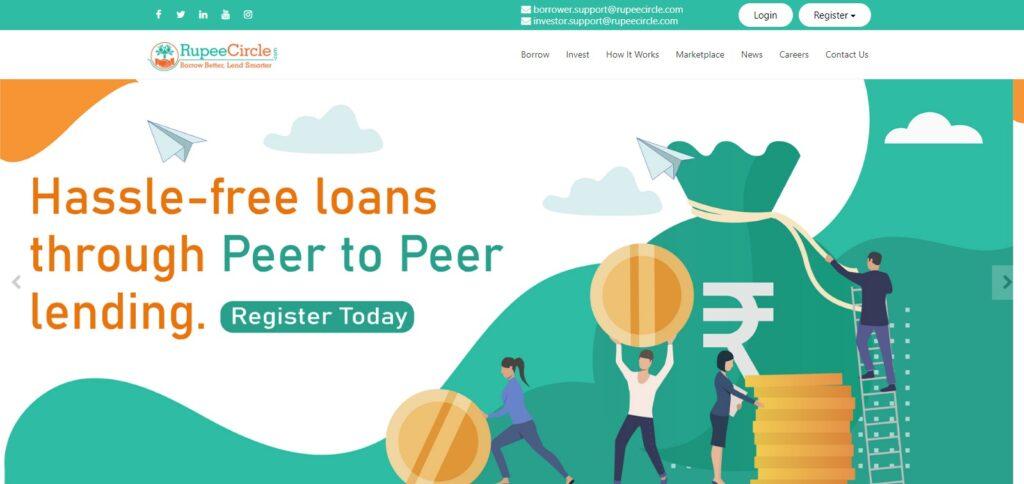
In order to determine a borrower’s capacity to repay the loan, Rupee Circle calculates a credit score for them based on their creditworthiness. Additionally, the platform provides investors with capabilities to diversify their portfolios across various loans and credit ratings.
In addition to interest rates that begin at 12% annually, Rupee Circle charges borrowers processing fees that range from 1.5% to 6% of the loan amount. Investors are additionally charged a 1% service fee on the principal repayment amount by the platform.
Even though Rupee Circle provides low rates and cutting-edge underwriting technologies, investors and borrowers should nevertheless take P2P lending risks like default risk and liquidity issues very seriously. Before making an investment or using the platform, it’s crucial to read the terms and conditions.
Can you earn money through peer-to-peer lending?
Peer-to-peer (P2P) lending does indeed offer the opportunity to make money. P2P lending entails providing financial assistance to people or small businesses online. By collecting interest payments on the loans you have backed, you can make money as an investor. P2P loans frequently have higher interest rates than those provided by conventional banks, which can give investors a greater return on their investment.
But it’s crucial to remember that P2P lending also entails dangers, such as the danger of borrower default, which might mean losing your investment. To reduce these risks, it’s critical to thoroughly examine the platform’s loan and borrower data and to diversify your investments over a range of loans and credit grades. In addition, several P2P lending platforms may have restrictions on who can invest and how much they can invest, so it’s important to review these requirements before investing.
Conclusion
Peer-to-peer (P2P) lending platforms have evolved as an alternative to conventional banking systems, offering investors new ways to diversify their investment portfolios while giving borrowers instant access to funds. P2P lending is now more widely available to consumers and small enterprises worldwide thanks to the growth of digital platforms.
A number of P2P lending platforms, including Upstart, Prosper, and LendingClub, have become extremely well-liked as a result of their cutting-edge underwriting technologies and affordable rates. These platforms offer a range of loan products, such as personal loans, business loans, and student loans, and connect borrowers with individual lenders.
Even though P2P lending can provide simple access to finance for borrowers and appealing returns for investors, it’s vital to think about the risks involved with this kind of investment. When assessing a P2P lending platform, one should take into account platform fees, default risk, and liquidity issues.
P2P lending can, in general, be a good investment choice for investors wishing to diversify their holdings and for borrowers searching for an alternative to conventional bank loans. To have a great and secure experience, it’s crucial to thoroughly investigate and evaluate the various P2P lending platforms accessible before investing or borrowing.
FAQ
What is peer-to-peer lending?
Peer-to-peer lending is a type of online lending that connects borrowers directly with investors, bypassing traditional banks and financial institutions.
How do P2P lending platforms work?
P2P lending platforms act as intermediaries, matching borrowers with investors. Borrowers apply for a loan on the platform, and if approved, their loan is listed on the marketplace for funding. Investors can then choose to invest in a borrower’s loan, with loans typically funded by multiple investors.
What types of loans are available on P2P lending platforms?
Most P2P lending platforms offer personal loans, business loans, student loans, and debt consolidation loans. The loan amounts, repayment terms, and interest rates vary depending on the platform and the borrower’s creditworthiness.
What are the benefits of P2P lending?
P2P lending can offer borrowers lower interest rates, faster access to funds, and a more personalized borrowing experience. For investors, P2P lending can provide higher returns than traditional savings accounts or bonds.
What are the risks of P2P lending?
P2P lending carries the risk of borrower default, which can result in the loss of your investment. Additionally, P2P lending platforms may have limited regulatory oversight, and there may be a lack of liquidity if you need to sell your investments before the loan term ends.







